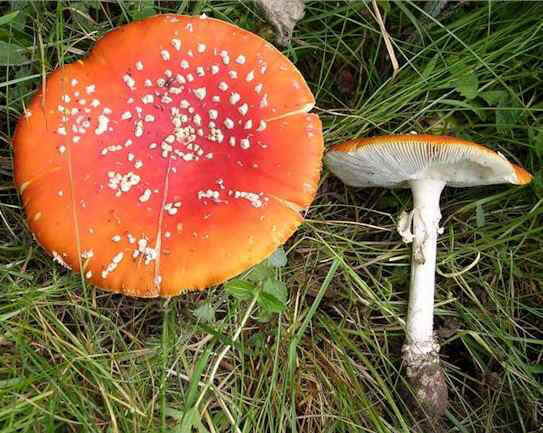A
partial veil initially encloses the gills, but
this is broken as the cap expands, often leaving
a thin ring of tissue near the top of the stalk
(stipe).

Fig.
1. Amanita muscaria,
the 'Fly Agaric', seen in top view (left) and
side view (right). Note the distinctive red
colour of the cap, with the white remains of the
universal veil. Also note the ring on the stipe
and the cup-like bulb at the base of the
toadstool (right). As a point of interest, note
the damage to the gills in the right-hand
specimen. This was caused by slugs, which often
feed on fungal fruitbodies. A. muscaria
is a mycorrhizal fungus, most frequently seen in
late summer in the litter layer beneath birch
trees (Betula spp.) but it can also form
mycorrhizal associations with pine trees (Pinus
spp.) in sub-tropical regions where pines, and
their associated mycorrhizal fungi, have been
introduced. [© Jim
Deacon]

Fig.
2. Close-up view of a fruitbody of A.
muscaria which has not yet expanded fully.
Note the fragments of the universal veil, which
are easily brushed off the cap, and the
distinctive bulbous base. [©
Jim Deacon]

Fig.
3. A species of Amanita,
possibly A. phalloides (the Death Cap).
This species is variable in colour, and the cap
can become flattened at maturity. The stem
thickens markedly towards the large basal bulb.[©
Jim Deacon]

Fig.
4. The same specimen as above, from a
different angle.[© Jim
Deacon]

Fig.
5. Amanita rubescens, the
'Blusher'. This is one of the commonest Amanita
species, with a reddish-brown coloured cap, pure
white gills, and white or rose-coloured patches
on the cap. Like most Amanita spp., A.
rubescens has a conspicuous ring on the
stipe (clearly seen in this image) and a bulbous
base. This fungus gains its common name (the
Blusher) from the fact that the base of the stem
typically bruises red when scratched. A.
rubescens is an ectomycorrhizal fungus,
often seen in mixed woodland, especially beneath
beech trees (Fagus sylvatica). [©
Jim Deacon]
The
extreme toxicity of several Amanita spp.
to humans is due to the presence of toxins such
as amatoxins and phallotoxins within the
fruitbody tissues. The amatoxins in particular
can be extremely potent because they are not
inactivated when they are ingested. They can bind
to actin microfilamants in human cells,
disrupting actin-based cellular dynamics and
leading to death. As noted in Chapter 3, some of
these toxins, such as phalloin (derived from
toadstools of the ‘death cap’ Amanita
phalloides) have become important tools in
cytological research because of their ability to
bind to specific cellular components such as
actin. In addition to these points
several Amanita spp., including the Fly
Agaric A. muscoides (Fig. 1), have
powerful hallucinatory properties. According to
Roger Phillips (Mushrooms and other fungi of
Great Britain and Europe: Pan Books Ltd.,
London, 1981) the Fly Agaric has powerful
hallucinatory and intoxicant properties,
affecting both humans and reindeer in Lapland.
The intoxicant can be recycled by drinking the
urine of an intoxicated person. BUT, at
least one death has been attributed to A.
muscaria. It is dangerous
to consume any Amanita
species.
GO TO HOME PAGE ?
GO TO PROFILES OF
FUNGI ?




